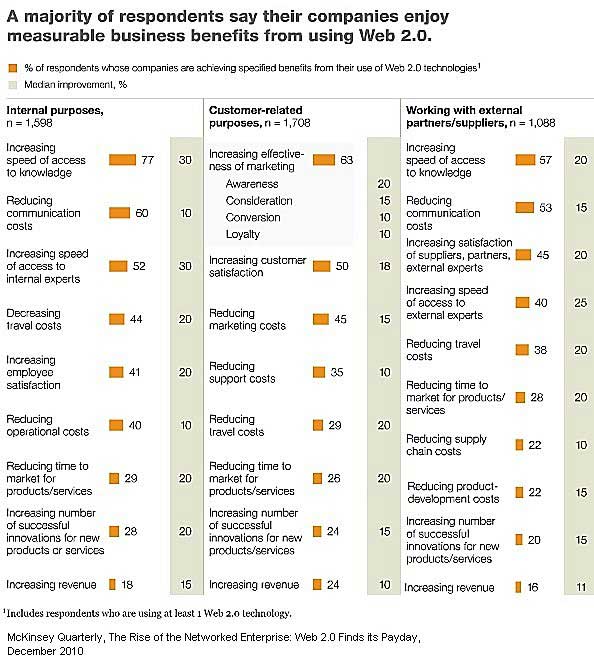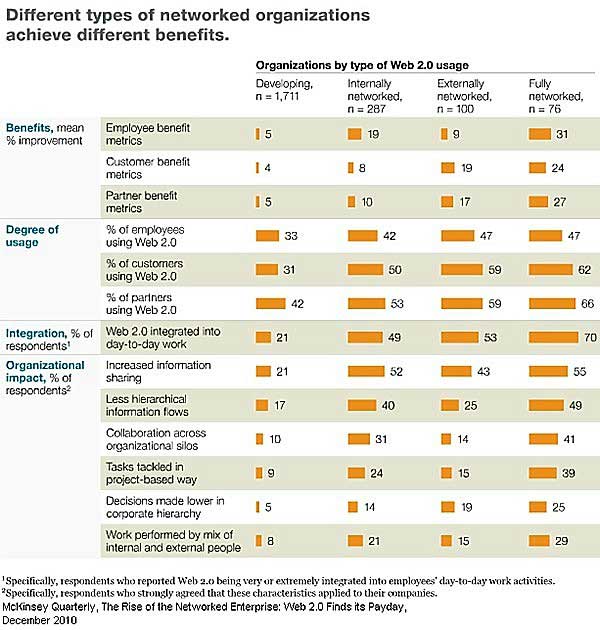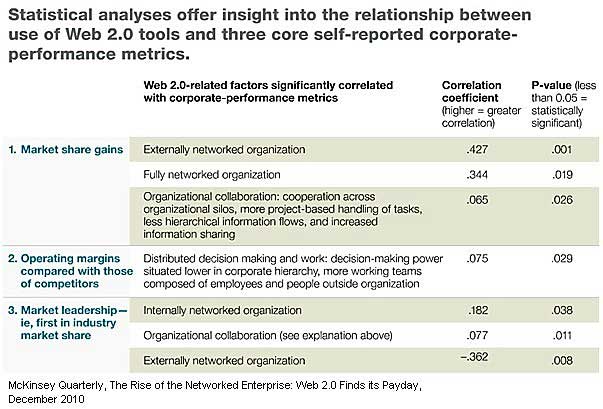Companies reporting the heaviest use of Web 2.0 technologies—particularly those deploying them beyond their own corporate walls—are deriving the greatest value, including more-effective marketing, stronger collaboration, and increased market share, according to a study by The McKinsey Global Institute.
Two-thirds of surveyed business executives report using Web 2.0 technologies in their organizations, with 2010 adoption levels higher across most social channels, including the following:
- Social networking: 40%, up from 28% a year earlier
- Blogs: 38%, up from 32%
- Video sharing: 33%, up from 31%
- RSS feed: 30%, up from 28%
- Podcasting: 25%, up from 23%
Healthy future spending plans underscore the value companies expect to gain from Web 2.0: Nearly two-thirds of execs at companies using Web 2.0 tools and technologies plan to increase future investments in such technologies, compared with one-half who said so a year earlier.
Below, other findings from McKinsey's annual survey of corporate executives titled The Rise of the Networked Enterprise: Web 2.0 Finds its Payday.
Among execs at companies using at least one Web 2.0 technology, most report they are receiving measurable business benefits—with nearly nine in ten reporting at least one benefit.
Marketing-related Benefits of Web 2.0
Among companies using Web 2.0 for customers-related purposes, key benefits include the following:
- 63% report more effective marketing.
- 50% report increased customer satisfaction.
- 45% report reduced marketing costs.
- 25% cite increased revenue.

Among those using Web 2.0 tools to work with partners and suppliers, 57% say such technologies speed up access to information, while 28% cite reduced time to market for products and services as a key benefit.
Looking for real, hard data that can help you match social media tools and tactics to your marketing goals? The State of Social Media Marketing, a 240-page original research report from MarketingProfs, gives you the inside scoop on how 5,140 marketing pros are using social media to create winning campaigns, measure ROI, and reach audiences in new and exciting ways.
Benefits by Type of Web 2.0 Use
For the study, companies were grouped according to the magnitude of the business benefits execs reported from the use of Web 2.0 technologies.
For example, among execs who say their companies are using Web 2.0, most (79%) are achieving a mean improvement of 5% or less across a range of business benefit metrics. Such "developing" companies report the lowest percentages of use among their employees (33%), customers (31%), and business partners (42%); and say that Web 2.0 is less integrated into their employees' day-to-day work (21%).

Three types of organizations, however, report much higher levels of business benefits from their use of Web 2.0 tools and technologies:
- Internally networked organizations are achieving benefits from using Web 2.0 primarily within their own corporate walls. Such companies comprise roughly 13% of those using Web 2.0, report a higher percentage of employees using Web 2.0 than developing organizations do (42% vs. 33%), and are more than twice as likely to report Web 2.0 tools integrated tightly into their work flows (49% vs. 21%).
- Externally networked organizations are achieving substantial benefits from interactions that spread beyond corporate borders, by using Web 2.0 to interact with customers and business partners. Execs at such companies (5% of those deploying Web 2.0) reported larger percentages of their employees (47%), customers (59%), and partners (59%) using Web 2.0.
- Fully networked enterprises, comprising 3% of companies, are deriving high levels of benefits from widespread use of Web 2.0. Across metrics analyzed, such companies report higher results than internally networked organizations, including employee benefit (31% vs. 19%), customer benefit (24% vs. 8%), and partner benefit (27% vs. 10%). Moreover, the integration of Web 2.0 into day-to-day activities is highest (70%) among this elite group, and such companies are most likely to report Web 2.0 technologies are promoting higher levels of collaboration via increased information sharing (55%), and by breaking down organizational silos (41%).
Web 2.0 Helps Companies Gain Market Share
Execs at more fully networked companies report capturing a broader set of benefits from their Web 2.0 investments. Across three metrics analyzed—operating profits, marketing leadership, and market share—market share gains are significantly correlated with fully networked and externally networked organizations.

Market leadership—ascribed to those organizations where execs report a top ranking in industry market share—is correlated positively with internally networked organizations that report high levels of organizational collaboration.
Market leadership also, however, is correlated negatively with externally networked organizations, while correlations of Web 2.0 variables associated with operating margin—arguably a more meaningful performance metric—are much lower.
View McKinsey's Web 2.0 adoption infographic.
About the data: For the fourth annual survey, McKinsey surveyed 3,249 executives across a range of regions, industries, and functional areas in December 2010.



